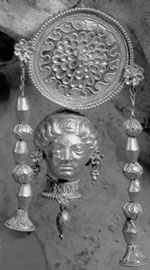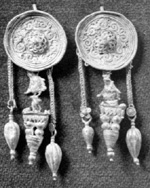|
|
From the eighth century B.C. the Greek started to found a series of colonies that extended along the coasts of the south of Italy , from Apulia to Campania,with some centres in Sicily:"Taranto,Cuma, Metaponto, Sibari, Crotone, Reggio, Paestum and Naples"these were the main centres of this big area colonized, that was then called Magna Graecia. In these colonies, that were then defenitely submitted by the Romans between 280and 265b.C., commerces, agriculture and handcraft flourished: furthermore, very important is the roll developed by these cities, spreading in Italy the Greek culture. The philosophy, the literature and the art of the Greek world influenced in an evident way the artistic and cultural activities of these colonies, that gave life to refined expression: flourishing was the production of ceramics and the working in bronze, while the wonderful temples of Paestum attest the grade of refinement and the decent measure reached by the local architecture.
In this lively cultural and economic climate, even the jeweller's is diffused and finds a great variety of expressions. The most splendid period of the jeweller's of the Magna Graecia is the one included between the fourth and third century B.C.: the main centre of production and diffusion of jeweller's is "Taranto" and the literary sources testify that it was a very vivacious artistic and cultural centre.We know the Hellenistic jeweller's through the archaeological rests effected in the tombs: in spite of the repeated sacks that happened in the course of centuries, the funeral equipments of these ancient inhabitants are extremely rich and allow to find in a rather agile way the of a jeweller's production no doubt important.
The typology of the jewels found in the tombs is evidently determined by the social class of the dead(deceased) ,yet, even in the most modest tombs a great number of earrings are found (the favourite ornament of these people), that in the most sumptuous tombs are often accompanied by diadems, crowns, necklaces and sometimes even by one ore two rings.Near Taranto fibulas are very rare and like we know, they were a determinate element of the clothes of those days, and even when they are found they are generally made of a material that is less precious, like silver, bronze,and sometimes iron: very diffused are the funeral equipments coming from the colonies of "Campania", where there aren't any earrings.
The earrings, that were the most frequent ornament among the Italiots, inhabitants of the Magna Graecia, have a great quantity of designs and solutions, in which the goldsmiths from "Taranto have showed a fantasy without limits. In the fourth century a certain type of earring was very fashionable, it had the the shape of a gold leech, flanked by filigreed decorations and pendants.; very appreciated were also the models with the most singular forms, for example the one with an helix, like the one found in "Taranto" and reproduced in fig,1. But the earring that was most widely diffused and popular in the Hellenistic period was the disc one fig.2, sometimes, like in the precious exemplary of the fourth century, found in "Crispiano" fig.4, the decorative element , magnificent and exuberant , is balanced
|
|
|
 |
|
FIG.4
|

|
| FIG.5 |
|
|
|
by the measure of the whole lot and by the Classic and severe line of the feminine line that is the centre of the earring. Human and animal figures fig.5. often recur as decorative motives in the jewels of these zones: in particular the leonine, retooken by the Classic art, is widely used in the decoration of necklaces, bracelets, rings and earrings. Even the "Nodus Herculeus", very famous in the ancient times because it was considered a magic knot able to remove the evils, among the inhabitants of the Magna Graecia assumes the meaning of an amulet and with this magic valence the goldsmiths use it diffusely in jewelry, as pendants , centre of belts, decoration of diadems and bracelets. A pair of earrings found in "Taranto" fig.3., shows how sometimes the desire of decorative exuberance excels the limits of a contained measure: these pendants are infact decorated with an elaborated vegetal composition, and with a series of human and animal figures , all of them supported and enriched by chains and pendants with the form of a bud. In the jeweller of "Taranto" an extraordinary richness of technique and decorative solutions is dedicated also to the creation of crowns and diadems, that become different from the simple gold band used in the Classic age.The most rich and spectacular exemplary is the flourished diadem found in "Canosa" and dated back to the third century B.C. fig.6. The diadem is made up of two thick laminae joined together previously with a clasp, so it was easy to wear ; the structure is covered by a light green lamina decorated with more than one hundred and fifty country flowers, fixed with very thin gold stalks, and enamelled of green, white, light blue, and red, with stamens and pistils of gold granules, drops of vitreous dough and precious stones, that give it a varied polychromy. In the third century B.C. the Magna Graecia colonies passed under the latin domination, and from that moment onwards the political vicissitudes of the Roman Italy followed; yet their cultural contribute to the hellinazation of the peninsula and of Rome was determinant, and in the latin jeweller's, clear traces of the motives and of the styles elaborated in the shops of these colonies, will found again.
|
|
|





